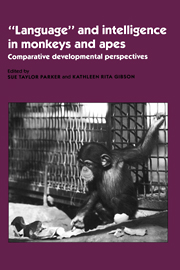Book contents
- Frontmatter
- Contents
- List of contributors
- Foreword
- Preface
- Acknowledgments
- Part I Theoretical frameworks for comparative developmental studies
- Part II Comparative developmental perspectives on cebus intelligence
- Part III Questions regarding imitation, “language,” and cultural transmission in apes and monkeys
- Part IV Developmental perspectives on social intelligence and communication in great apes
- Part V Development of numerical and classificatory abilities in chimpanzees and other vertebrates
- Part VI Comparative developmental perspectives on ape “language”
- 19 The cognitive foundations for reference in a signing orangutan
- 20 Grammatical combination in Pan paniscus: Processes of learning and invention in the evolution and development of language
- Index
19 - The cognitive foundations for reference in a signing orangutan
Published online by Cambridge University Press: 11 May 2010
- Frontmatter
- Contents
- List of contributors
- Foreword
- Preface
- Acknowledgments
- Part I Theoretical frameworks for comparative developmental studies
- Part II Comparative developmental perspectives on cebus intelligence
- Part III Questions regarding imitation, “language,” and cultural transmission in apes and monkeys
- Part IV Developmental perspectives on social intelligence and communication in great apes
- Part V Development of numerical and classificatory abilities in chimpanzees and other vertebrates
- Part VI Comparative developmental perspectives on ape “language”
- 19 The cognitive foundations for reference in a signing orangutan
- 20 Grammatical combination in Pan paniscus: Processes of learning and invention in the evolution and development of language
- Index
Summary
Introduction
Beginning in the 1960s, Gardner and Gardner (1969), Premack (1972), and Rumbaugh, Gill, and von Glasersfeld (1973) first demonstrated that chimpanzees could represent words or ideas using a set of gestural signs, computer lexigrams, or plastic tokens. In subsequent research, Fouts (1973), Miles (1976, 1983), Patterson (1978), and Terrace, Petitto, Sanders, and Bever (1979) extended these language studies of the gorilla and orangutan and expanded the focus to such issues as ape-to-ape communication, discourse ability, and the relationship between language and other cognitive processes. Controversy arose over the degree to which an ape's use of these systems could be called “language,” the extent of animal linguistic abilities, and whether or not other species, such as aquatic mammals and birds, could exhibit similar skills (Brown, 1973; Epstein, Lanza, & Skinner, 1980; Le May & Geschwind, 1975; Limber, 1977; Mounin, 1976; Pepperberg, P&G18); Sebeok & Umiker-Sebeok, 1980; Terrace et al., 1979).
Project Chantek is an attempt to advance our knowledge of animal intelligence and “language” ability through a developmental perspective. It consists of a longitudinal sign language study with an orangutan named Chantek. The orangutan is the only great ape from Asia (the chimpanzee and gorilla are found in Africa). The orangutan was thought by many to be less likely to develop language skills than chimpanzees, primarily because of beliefs that chimpanzees are more intelligent and evidence that the African apes had a more recent evolutionary separation from humans than did the orangutan.
- Type
- Chapter
- Information
- 'Language' and Intelligence in Monkeys and ApesComparative Developmental Perspectives, pp. 511 - 539Publisher: Cambridge University PressPrint publication year: 1990
- 111
- Cited by


